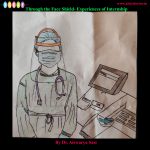Some discoveries are the result of slow, painstaking (some would say painful) research, logical step following logical step until a faint glimmer of light appears at the end of the tunnel. Other discoveries emerge as a bolt out of the blue – they still need to be recognised as such though. And there are some where Chance conspires with Circumstance to produce something quite revolutionary.

Alexander Fleming’s discovery of the antimicrobial property of the penicillium mould falls into this last category. Some might dismiss him as a sloppy microbiologist who failed to dunk all his petri dishes into the bucket of antiseptic. The mould which grew and which cleared the staphylococci colonies (penicillium – a brush) might not normally have grown at all. But as Richard Gordon (better known for his Doctor series books which were later serialised for television) writes in his book “The Alarming History of Medicine” – Fleming had all the luck! The petri dish was exposed to one of Britain’s most horrible Augusts, the low temperature being ideal for the mould to grow. The fact that the mould itself was around was more than chance – it did not descend from the ceiling but rose from the lab below where Alexander Fleming’s colleague had a laboratory and was studying moulds! Fleming’s departure to Scotland on holiday gave the penicillium time to work its magic! When Fleming, Florey and Chain were awarded the Nobel Prize in 1945 “for the discovery of penicillin and its curative effect in various infectious diseases” it would spark a debate about the actual contribution of Fleming – was he merely around at the right time? Others will dismiss this view as uncharitable, since Fleming still had to derive the importance of his observation.

Several centuries before Fleming – a young, French army barber surgeon was to be similarly smitten by Chance. It was 1537 – the battle for Turin. Now that guns had become an integral part of warfare – much of the casualties were from gunshot wounds. Gunpowder was generally thought to be a poison and therefore had to be burnt out. The method employed was by cauterization with boiling oil and treacle. On the day in question, the oil ran out. Ambroise Paré who had obediently followed the instructions of his seniors was in a dilemma. He decided to improvise – egg yolk, oil of roses and turpentine – he then left, expecting his patients to be dead in the morning. Surprisingly, not only were his patients alive but they looked better than those treated conventionally. “Abandon this miserable way of burning and roasting”* he urged, with little success. But that did not prevent him from pursuing his own path. He abandoned cauterization in favour of a practice that had fallen into disuse – tying the arteries with bits of thread or cord – the ligature was reborn. Ambroise Paré combined his love of innovation (he also developed a truss for hernia, invented the artery forceps and created all sorts of prostheses to help war veterans) with an uncommon humility, for one who was honoured much later in his life. He would often say – “I dressed him and God healed him.”*
*Patrick Pringle. The Romance of Medical Science. George G Harrap & Co. Ltd. 1948








